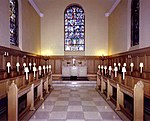Greendykes

Greendykes is a neighbourhood of Edinburgh, the capital of Scotland. It was originally a council scheme, consisting mostly of low-rise flats but also two 15-storey tower blocks (Greendykes House and Wauchope House). It is sometimes considered to be part of Craigmillar; areas such as Niddrie, Niddrie Mains and Newcraighall are also situated nearby. Greendykes was ranked as the 4th most deprived area in Scotland in the Scottish Index of Multiple Deprivation 2006. The low-rise flats were demolished between 2009 and 2010 and rebuilt to an extent over the next decade. Affordable housing is being provided through a joint venture known as PARClife between the city council and EDI, a private company 100% owned by the Council. Much of the new housing in the area is built to the south of the original Greendykes housing, on the opposite side of the Niddrie Burn (itself landscaped as a southern extension of Hunter's Hall Public Park). Castlebrae Community High School is located at the western edge of the neighbourhood, adjacent to Castleview Primary School.
Excerpt from the Wikipedia article Greendykes (License: CC BY-SA 3.0, Authors, Images).Greendykes
Princess Mary Road, City of Edinburgh Craigmillar
Geographical coordinates (GPS) Address Nearby Places Show on map
Geographical coordinates (GPS)
| Latitude | Longitude |
|---|---|
| N 55.929166666667 ° | E -3.1269444444444 ° |
Address
Princess Mary Road 1
EH16 4FU City of Edinburgh, Craigmillar
Scotland, United Kingdom
Open on Google Maps








